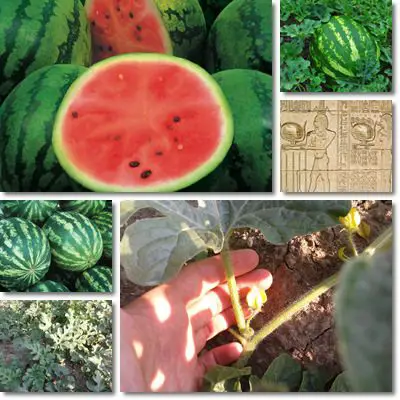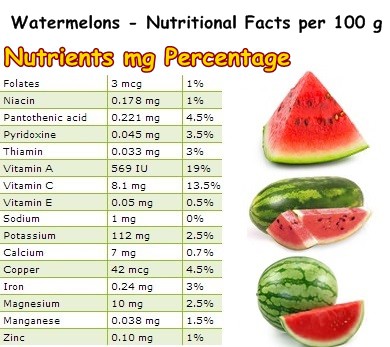In summer the days are long and hot, the sun is scorching and we feel as if we are slowly melting even when we are relaxing besides the pool with a refreshing beverage in our hands. When temperatures seem to go through the roof, many of us feel like all our energy is being drained slowly and there seems to be no remedy for it. Fortunately, there is: a great energy-boosting fruit, nutritious and hydrating called a watermelon. Originating in Africa, watermelons are high in water, low in calories and a good source of vitamin C, B vitamins, essential minerals and important antioxidants such as lycopene.
What is watermelon?
The watermelon (Citrullus lanatus) is a fruit, more exactly a berry. It belongs to the Cucurbitaceae family, meaning it is related to gourds, squash, zucchini and pumpkin, but also cucumbers and melons in general. There are actually quite a few watermelon varieties in addition to the green rind, pink-red, sweet flesh watermelon we all know and love. Some varieties taste are bitter, others quite bland, reminiscent of gourds or cucumbers. The fruit is known to occur naturally in the wild and is also extensively cultivated.

What does watermelon look like?
The watermelon is a large fruit that can easily grow to over half a meter in diameter. On the outside it has an inedible, green rind with a specific color pattern: elongated, dark, green stripes over a lighter-colored green. Depending on the cultivar, the stripes may be more linear or look similar to lightning bolts or as if they are a result of a watercolor painting experiment. Some varieties have a darker green rind without any distinguishable pattern.
The watermelon plant is a vine that creeps along the ground which means the fruit also rests on the ground until it’s ready to be harvested. The portion of the rind in contact with the ground is usually discolored, not green but cream-colored or a slight earthy yellow hue. This part is often used to tell if a watermelon is ripe and ready to be harvested – if it’s a warm yellow tone, the watermelon is ripe and likely very sweet, ready to eat.
Between the inedible green rind and the sweet flesh there is also a light-colored, white to pale green, edible portion of rind, a few centimeters thick, unimaginatively called the white part of watermelon rind.
On the inside, the fruit is not divided in any way and there are usually a lot of small, brown-black seeds. Seedless watermelon varieties also exist and are quite popular due to making eating the fruit easier.
What does watermelon taste like?
The most common watermelon variety is the red fleshed watermelon. The variety has a delicious, pleasantly firm, but slightly stringy, extremely juicy and sweet pink to dark red flesh with a strong fruity scent. The best watermelons have a honey-like sweetness to them. However, this is but one variety.
It may come as a surprise, but inside watermelon can also be yellow, orange, light green or white, and it can taste sweet or not. Vs red, yellow fleshed watermelon has a more straightforward sweet taste, with deep honey flavor notes, and is just as juicy and crisp, slightly denser, but not at all stringy.
Another increasingly popular variety, the orange fleshed watermelon, has a characteristic watermelon taste: sweet and crisp, with fresh fruity flavors and scent. Ideally, the flesh is soft, extremely juicy and crisp.
There is also a white fleshed watermelon which is reported to rival yellow watermelon in terms of taste: white watermelon, the dessert kind, is extremely sweet with strong fruity flavors.
As a testament to how good white watermelon tastes, some of the most popular cultivated varieties are called names like White Sugar Lump.
Watermelon varieties that are not sweet have either a bitter or bland taste, similar to rather tasteless gourds or cucumbers (e.g. the citron watermelon). These varieties are less popular, yet just as nutritious as our all-time summer favorite, the common sweet watermelon.
What does the white part of the watermelon rind taste like?
In watermelon, the part between the tough green rind and sweet inner flesh is also edible, albeit more bland tasting, and contains important antioxidants and other biologically active constituents with major benefits for health, including cardiovascular health and muscle function. It’s called the white part of the watermelon rind and it has many uses, culinary and therapeutic alike.
In addition to being consumed fresh as fruit, along with the sweet flesh, it is also consumed for its benefits for blood circulation and blood pressure, for its benefits for muscles, for exercise support, and used to make pickles and tea.

Watermelon seeds and rind
The unripe seeds are a milky white color and soft, slightly chewy, but edible. The ripe seeds are a luscious, dark brown with a hard outer shell and milky white on the inside.
Watermelon seeds are edible, but they pose certain health risks and are best avoided because they may accidentally obstruct breathing or cause complications for diverticulitis sufferers and, in rare cases, bowel obstruction.
The raw rind is inedible, but boiling or pickling it can render it edible.
Watermelon benefits for dehydration
Why are watermelons recommended for consumption during summer? First of all, the fruit is 91.45% water and helps keep us hydrated. It further has 6.20 g of natural sugars for every 100 grams of fruit – the natural sugars get absorbed quickly in the blood, raising blood sugar levels and providing quick energy for the body to use. As a result, eating watermelon helps combat hypoglycemia and boost energy levels instantly.
When the temperatures are high during summer, we sweat excessively in order to keep cool which means we lose more water than usual, in addition to electrolytes.
Water is essential for practically every body function so it is imperative that we replace all that has been lost as soon as possible. And a great way to do this is by eating watermelon and other foods rich in water.
Eating watermelon will not only help prevent and reverse dehydration as a result of exposure to high temperatures, but because the fruit is so sweet, chances are you will eat more of it and thus increase your water intake for good kidney and cardiovascular function.
Excess water is quickly eliminated and the diuretic effect of the fruit is great for our kidneys, the increase in urine output helping the kidneys get rid of many toxins this way.
Even more, eating watermelon when it’s hot outside can help prevent fainting because the high water content of the fruit helps increase blood volume.
Most people believe that dehydration is not a serious issue and take things lightly. But the truth is that when we sweat excessively our body loses not only water, but also important minerals with electrolyte properties and vitamins. As a consequence, many people end up fainting or have little to no energy, not to mention previous medical conditions, especially cardiovascular problems, often worsen with low fluid intake.

Watermelon nutrition facts and more benefits
Some of the benefits of watermelon are a direct result of its low energetic value. How many calories in watermelon? Watermelon has only 30 kcal (kilocalories, calories) per 100 g (grams) of fruit and around 261.5 kcal per wedge (one wedge weighs around 285 grams). This low calorie content makes it an ideal food for weight loss and weight management, helping create a good calorie deficit.
Other nutritional facts per 100 grams of fruit:
- 7.55 g (grams) of carbohydrates
- 6.20 g of sugar
- 0.61 g of protein
- 0.15 g of fat
- 0.4 g of fiber
- 91.45 g of water
A serving of 100 g of fresh watermelon provides good amounts of the pigmented antioxidants beta-carotene and lycopene, and vitamin C. Beta-carotene is a carotenoid with vitamin A activity – it gets absorbed and then metabolized in the body and used in place of preformed vitamin A.
Vitamin A, whether preformed or from pro-vitamin A antioxidants, is good for eyesight, improving vision acuity, as well as supports the health of the mucous membranes of the eyes, nose, mouth, throat, lungs and stomach. Healthy mucous membranes acts as a barrier against the outside world, with benefits for immunity.
Lycopene from red fleshed watermelon has no vitamin A activity, but studies show it scavenges free radicals and counteracts cell damage, as well as has scientifically proven blood pressure lowering benefits.
All watermelon colors have good amounts of vitamin C, a strong antioxidant and anti-inflammatory vitamin with many benefits for health. Studies show vitamin C supports and modulates the immune system function, boosting immunity. Vitamin C also lowers levels of several inflammation markers in the body such as C-reactive protein, with benefits for inflammatory conditions such as arthritis, helping counteract joint swelling and pain.
Eating watermelon is also good for teeth and gums. Vitamin C in the fruit helps produce collagen types 1 and 3 with benefits for bone density and tooth structure, and helps gums adhere to teeth as well as prevents bleeding from gums via a direct action on capillaries. Because the fruit is also sweet and simply incredibly delicious, you will most likely eat more than 100 grams at once and thus enjoy a far greater intake of vitamin C and other vitamins and associated benefits for health.
Watermelon with red flesh is naturally rich in lycopene, a pigmented phytochemical and carotenoid antioxidant responsible for the red color of the fruit. The antioxidant is also found in high amounts in tomatoes, red carrots, pink grapefruit, pink fleshed guava and gac fruit and has scientifically proven blood pressure lowering benefits.
Together with lycopene, vitamin C and beta-carotene in watermelon help lower risks of cardiovascular disease. These biologically active compounds reach your bloodstream via consumption of the fruit and help clean arteries of plaque deposits (vitamin C), counteract oxidative damage to blood vessels by scavenging free radicals (vitamin C, lycopene, beta-carotene) and reduce inflammation conducive to atherosclerosis.
All three compounds further have important antioxidant properties with proven anticancer effects, including antiproliferative, apoptotic and antitumor, adding to the reasons why you should eat watermelon.
Though the amounts are not significant, watermelon also contains vitamins B1, B2, B3, B5, B6 and choline which provide modest benefits for digestion, energy metabolism, skin and brain and nervous system health.
The fruit further contains small amounts of calcium, iron, magnesium, manganese, phosphorus, potassium and zinc, essential dietary minerals with a tonic action and electrolyte properties with benefits for cardiovascular health. Magnesium and potassium in particular are good for the hear, regulating blood pressure numbers.
When it’s hot outside and you feel low on energy or feel like you are about to faint, eating a wedge of watermelon can help by providing an almost instant boost in energy and vitality with benefits for dehydration and associated side effects.
Watermelon seeds are also a source of important micronutrients, particularly dietary minerals, and are great for staying healthy. If you have conditions that prevent you from eating seeds like watermelon seeds or fruits with seeds like kiwifruit, avoid them altogether.
Watermelons are especially good for kids. Because they are incredibly sweet and juicy, there isn’t a child who will say no to a refreshing slice of fruit or even a large glass of watermelon juice. The fruit can easily replace a sweet snack and you will have the certainty that both you and your child stay hydrated in hot weather.
Watermelon side effects
Strong diuretic properties – may cause mineral loss
One of the side effects of eating watermelon is its high water content which makes it a highly diuretic fruit. When eaten in unreasonably high amounts and too frequently, it can promote diuresis and cause mineral losses that deplete the body of essential electrolytes.
Presents risk of foodborne illness such as gastroenteritis
If the fruit is dirty, contaminated or spoilt, it can cause foodborne illness such as infectious gastroenteritis. Irrigation with contaminated water can spread infectious agents on the rind.
Cutting the fruit then distributes the pathogenic agents onto the flesh which then becomes a source of foodborne illness. If the flesh has an off-smell or is too mushy or piquant or sour to the taste, then the fruit has a high chance of being spoilt and should be discarded.
Watermelon and diabetes
Can you eat watermelon if you have diabetes? While diabetics can eat just about anything, including fruits like watermelon, they are advised to keep intake low to avoid raising their blood sugar levels too much. Watermelon has a high glycemic index (GI index: 72), meaning it’s likely to cause blood sugar spikes.
But if eaten in small amounts, preferably not every single day or more than one serving a day, watermelon can be safely and successfully incorporated into a diabetic diet without causing side effects. Small portions carry a low glycemic load (GL score: 5) and make it safe and good to eat watermelon in diabetes by limiting effects on blood sugar.
Conclusion
Watermelon is an absolutely delicious fruit, nutritious, not to mention versatile. Watermelon rind is highly appreciated in many cuisines, often cooked and served by itself, as an independent dish, or as a side dish, pickled or served as jam on bread or in thin pancakes called crepes. And did you know that watermelon seeds were found in the tomb of Pharaoh Tutankhamen himself? The fruit was also depicted in numerous Egyptian hieroglyphs which is consistent with findings that suggest watermelon cultivation dates back to ancient Egyptian times.
